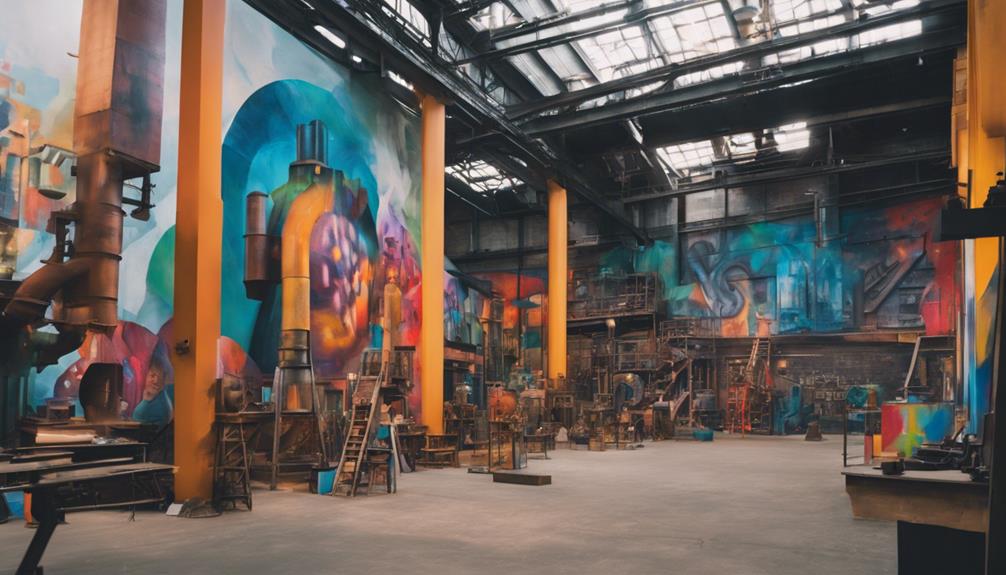Pittsburgh's alluring blend of industrial charms and modern renewal traces back to its mid-19th-century industrial boom, sculpted by abundant resources and strategic positioning. Steel's history, under figures like Andrew Carnegie, etched an iconic urban landscape. Today, sites like the Strip District and Lawrenceville reflect a transformation: South Side Works now a mixed-use area; Carrie Blast Furnaces a National Historic Landmark. Digital tools drive modernist projects, intertwining technology with architectural brilliance. Educational institutions, led by Carnegie Mellon University and University of Pittsburgh, foster a cultural revival. Pittsburgh's vibrant arts scene, from the Andy Warhol Museum to open-air festivals, radiates creativity and heritage.
Key Takeaways
- Pittsburgh's industrial heritage rooted in 19th-century industrial prowess and iconic figures like Andrew Carnegie.
- Transformation of industrial sites like South Side Works and Carrie Blast Furnaces into vibrant mixed-use areas.
- Integration of advanced technologies in urban development projects, blending innovation with architectural brilliance.
- Educational institutions like Carnegie Mellon University drive artistic and intellectual revival in the city.
- Vibrant arts scene showcased through museums, festivals, and diverse performing arts groups.
Historical Roots of Pittsburgh's Industry
Pittsburgh's industrial prowess traces back to the mid-19th century, driven by abundant natural resources and its strategic location at the confluence of three rivers. The city's steel history began with figures like Andrew Carnegie, whose steel empire played a pivotal role in shaping Pittsburgh's identity as the Steel City. General John Forbes recognized the potential of Pittsburgh's location and initiated its development into a key industrial hub.
Immigrants from various European backgrounds flocked to the city seeking employment in the booming steel industry, further enriching its cultural tapestry.
The steel industry not only defined Pittsburgh's economy but also left a profound mark on its urban landscape. Iconic steel mills and factories dotted the city, symbolizing its status as the Steel Capital of the World. However, as the steel industry declined, Pittsburgh underwent a period of urban renewal, transforming itself into a diversified economy centered around finance, education, medicine, and technology.
The legacy of Pittsburgh's industrial past continues to influence its present-day identity, blending history with modern innovation.
Transformation of Industrial Sites

The evolution of former industrial sites in Pittsburgh marks a significant shift towards vibrant, modern urban spaces. Areas like the Strip District and Lawrenceville have developed into bustling neighborhoods filled with trendy shops, restaurants, and art galleries.
The once-bustling steel mill site of South Side Works has been redeveloped into a mixed-use area offering shopping, dining, entertainment, and residential options.
Preserving Pittsburgh's industrial past, the Carrie Blast Furnaces from the former U.S. Steel Homestead Works now stand as a National Historic Landmark, offering guided tours to showcase the city's rich heritage.
Additionally, the Pittsburgh Technology Center, situated on the former Jones and Laughlin Steel Mill site, has become a thriving hub for technology and research companies, shaping the city's modern economic landscape.
Furthermore, the transformation of the former Heinz factory in the North Side into a mixed-use complex with offices, apartments, and retail spaces exemplifies Pittsburgh's successful shift from its industrial roots to a modern urban development.
Innovation and Technology Integration
Integrating cutting-edge technology into architectural projects has been pivotal in reshaping Pittsburgh's modern urban landscape. The infusion of advanced technologies, such as digital design tools, has revolutionized the city's approach to architectural transformations, particularly in modernist projects.
Here are some key points highlighting the significance of innovation and technology integration in Pittsburgh's modern renewal:
- Digital design tools played a vital role in the creation of modernist projects.
- The integration of cutting-edge technology in architectural innovations redefined Pittsburgh's urban landscape.
- Modern renewal projects in Pittsburgh exemplified a harmonious blend of technology and architectural brilliance.
- The incorporation of advanced technologies marked a new era of innovation in urban development for Pittsburgh.
Through the strategic integration of technology, Pittsburgh has successfully embraced a forward-thinking approach to urban development, setting a new standard for modern renewal projects in the city.
Education and Cultural Revival

In Pittsburgh, the nexus of educational institutions and cultural revival forms a dynamic core driving the city's artistic and intellectual renaissance. Carnegie Mellon University and the University of Pittsburgh stand out as pillars of this revival, nurturing creativity and innovation among students and faculty. These universities not only provide quality education but also actively contribute to the city's cultural landscape through partnerships with local artists, musicians, and community organizations.
The collaboration between academia and the arts has led to the revitalization of historic landmarks such as the Strip District and Lawrenceville, preserving the city's heritage while embracing modernity.
Moreover, Pittsburgh's commitment to cultural revival is evident in initiatives like the Three Rivers Arts Festival and diverse cultural events that showcase the city's vibrant artistic scene. Cultural institutions like the Carnegie Museums, Heinz History Center, and Andy Warhol Museum further enrich Pittsburgh's cultural tapestry, attracting locals and visitors alike to experience the city's diverse artistic offerings.
Vibrant Arts Scene in Pittsburgh
Pittsburgh's arts scene pulsates with energy, showcasing a diverse array of creative expressions and cultural experiences. From the world-renowned Pittsburgh Symphony Orchestra to the avant-garde exhibits at the Carnegie Museum of Art, the city stands as a vibrant cultural hub. Here are some highlights of Pittsburgh's thriving arts scene:
- The Andy Warhol Museum: Celebrating the iconic pop artist's legacy, this museum offers a unique glimpse into Andy Warhol's life and work.
- Performing Arts Galore: With over 200 performing arts groups, Pittsburgh provides a stage for ballet, opera, theater, and more, catering to diverse artistic tastes.
- Three Rivers Arts Festival: This annual event transforms the city into an open-air gallery, showcasing local and international artists and performers.
- Artistic Heritage Sites: From the historic Saint Anthony Chapel to the contemporary Mattress Factory, Pittsburgh's artistic heritage is preserved and celebrated through various museums and cultural landmarks.
Frequently Asked Questions
Who Is the Largest Employer in Pittsburgh?
UPMC holds the title of the largest employer in Pittsburgh, boasting a workforce of over 92,000 individuals across various healthcare roles. Its extensive network of hospitals, outpatient facilities, and research centers not only caters to the healthcare needs of the Pittsburgh community but also serves as a significant economic driver for the city.
With its diverse range of services, UPMC plays a pivotal role in shaping the local employment landscape and economy.
What Happened to the Pittsburgh Steel Industry?
The Pittsburgh steel industry faced a decline in the late 20th century due to economic shifts and global competition. This decline resulted in massive job losses and economic challenges for the region.
However, efforts to diversify the economy and focus on technology, healthcare, and education helped Pittsburgh recover from the steel industry's downturn.
Today, Pittsburgh's industrial heritage is celebrated through museums, monuments, and preserved sites that honor its steelmaking past.
What Is Pittsburgh's Main Industry?
Pittsburgh's main industry has shifted from steel production to a diverse economy that includes finance, technology, education, and healthcare.
Today, the city thrives on industries like robotics, biomedical technology, and renewable energy.
This transformation reflects Pittsburgh's ability to adapt and innovate in response to changing economic landscapes.
The city's industrial past continues to influence its modern renewal efforts, showcasing a blend of historic charm and forward-thinking development strategies.
What Is Pittsburgh Known for Economically?
Pittsburgh is known for its economic diversification, shifting from a steel-focused economy to finance, education, medicine, and technology sectors. The city houses eight Fortune 500 companies and is the third-largest research and development center in the U.S.
Pittsburgh's economy thrives on a mix of industries, including advanced manufacturing, healthcare, robotics, and energy. The city's economic growth is supported by a strong focus on innovation, entrepreneurship, and sustainable development.
Conclusion
To sum up, Pittsburgh's industrial past has paved the way for a modern renewal that embraces innovation, technology, education, and culture.
The transformation of industrial sites has sparked a vibrant arts scene, showcasing the city's resilience and creativity.
With a focus on revitalization and progress, Pittsburgh continues to charm visitors and residents alike with its blend of historical roots and modern amenities.










